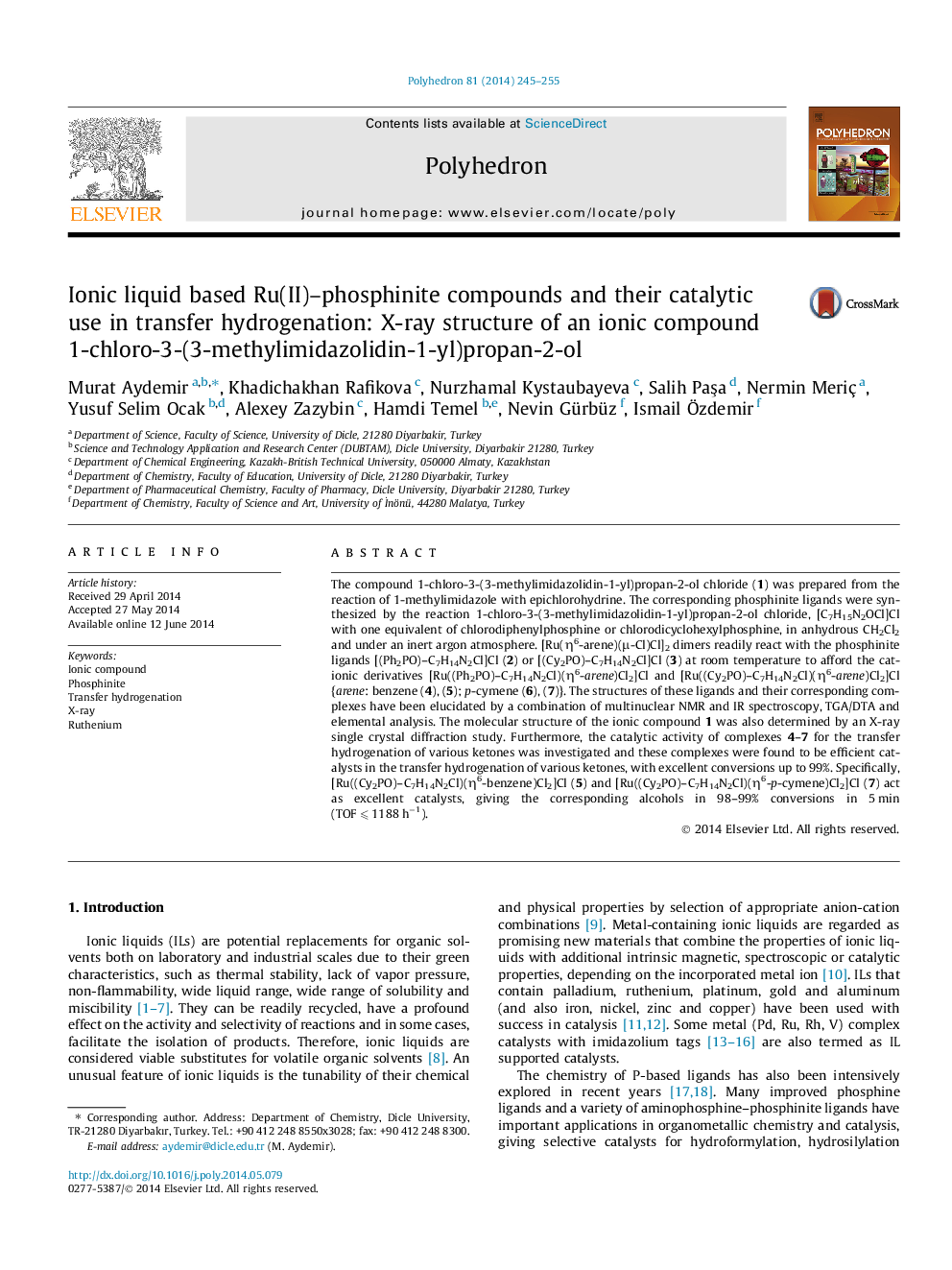| کد مقاله | کد نشریه | سال انتشار | مقاله انگلیسی | نسخه تمام متن |
|---|---|---|---|---|
| 1334426 | 1500258 | 2014 | 11 صفحه PDF | دانلود رایگان |

The compound 1-chloro-3-(3-methylimidazolidin-1-yl)propan-2-ol chloride (1) was prepared from the reaction of 1-methylimidazole with epichlorohydrine. The corresponding phosphinite ligands were synthesized by the reaction 1-chloro-3-(3-methylimidazolidin-1-yl)propan-2-ol chloride, [C7H15N2OCl]Cl with one equivalent of chlorodiphenylphosphine or chlorodicyclohexylphosphine, in anhydrous CH2Cl2 and under an inert argon atmosphere. [Ru(η6-arene)(μ-Cl)Cl]2 dimers readily react with the phosphinite ligands [(Ph2PO)–C7H14N2Cl]Cl (2) or [(Cy2PO)–C7H14N2Cl]Cl (3) at room temperature to afford the cationic derivatives [Ru((Ph2PO)–C7H14N2Cl)(η6-arene)Cl2]Cl and [Ru((Cy2PO)–C7H14N2Cl)(η6-arene)Cl2]Cl {arene: benzene (4), (5); p-cymene (6), (7)}. The structures of these ligands and their corresponding complexes have been elucidated by a combination of multinuclear NMR and IR spectroscopy, TGA/DTA and elemental analysis. The molecular structure of the ionic compound 1 was also determined by an X-ray single crystal diffraction study. Furthermore, the catalytic activity of complexes 4–7 for the transfer hydrogenation of various ketones was investigated and these complexes were found to be efficient catalysts in the transfer hydrogenation of various ketones, with excellent conversions up to 99%. Specifically, [Ru((Cy2PO)–C7H14N2Cl)(η6-benzene)Cl2]Cl (5) and [Ru((Cy2PO)–C7H14N2Cl)(η6-p-cymene)Cl2]Cl (7) act as excellent catalysts, giving the corresponding alcohols in 98–99% conversions in 5 min (TOF ⩽ 1188 h−1).
The synthesis and characterization of novel phosphinite ligands based on ionic liquids and their corresponding ruthenium(II)–arene complexes are described. These ligands and their corresponding complexes have been characterized by a combination of multinuclear NMR and IR spectroscopy, TGA/DTA, elemental analysis and X-ray analysis. 1H–{31P} NMR, 1H–13C HETCOR or 1H–1H COSY correlation experiments were used to confirm the spectral assignments. The molecular structure of the ionic compound 1 was also determined by an X-ray single crystal diffraction study. Furthermore, the catalytic activity of complexes 4–7 in the transfer hydrogenation of various ketones was investigated. To the best of our knowledge, there is no report on the utility of this type of complex, including phosphinite ligands and based on ionic liquids, in Ru(II) catalyzed transfer hydrogenation reactions. These complexes were found to be efficient catalysts in the transfer hydrogenation of various ketones with excellent conversions of up to 99% in the presence of 2-propanol/KOH. Specifically, [Ru((Cy2PO)–C7H14N2Cl)(η6-benzene)Cl2]Cl (5) and [Ru((Cy2PO)–C7H14N2Cl)(η6-p-cymene)Cl2]Cl (7) act as excellent catalysts, giving the corresponding alcohols in 98–99% conversions in 5 min (TOF ⩽ 1188 h−1).Figure optionsDownload as PowerPoint slide
Journal: Polyhedron - Volume 81, 15 October 2014, Pages 245–255